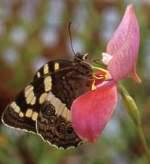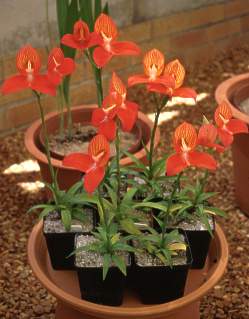Disa uniflora
Disa uniflora Bergius
Family: Orchidaceae
Common names: pride of Table Mountain, red disa (Eng.), rooidisa (Afr.)
Introduction
This famous red orchid, emblem of the Western Cape, is strictly protected.

Description
Description
Showy flowers in shades of red, pink and very occasionally yellow are borne during summer from December to March with a peak flowering period during mid-February.
Distribution and habitat
Distribution description
This evergreen, terrestrial (ground) orchid grows under perennially wet or moist conditions. It is found along stream banks, waterfalls or wet cliffs on Table Mountain and other mountain localities of the Western Cape.
Ecology
Ecology
The butterfly Meneris tulbaghia is the only known pollinator of Disa uniflora.

Growing Disa uniflora
Grow
To grow Disa uniflora successfully one must remember the following.
Disas require a cool environment with average temperatures ranging between 10-26°C. Disas can however tolerate summer temperatures above 30°C, provided they have adequate moisture, humidity and free air movement. A well drained, coarse growing medium contributes to the continual flow of moisture, nutrients and efficient aeration to the plant. Disas prefer partial shade, but good light conditions are essential for flowering and to enhance rich flower colour.
In nature Disa uniflora multiplies vegetatively by producing stolons that develop into new plants. After flowering the plant and its tuber die back and to provide food for the production of a fresh tuber and shoot.
As the plant produces young plants vegetatively, propagation may be done simply by division. Established plants are divided after flowering. Wash the growing medium from the roots and carefully separate the young plants before repotting.
Another method of propagation is from seed. Fresh seed is sown on washed Irish peat or sphagnum moss. Fill the pot with a layer of coarse, washed river sand and place a layer of peat or sphagnum over it. Sow the seed evenly and lightly spray the entire surface with a suitable fungicide, e.g. Kaptan. Cover the pot with clear plastic, held firmly in place with an elastic band or use a pane of glass. Place in a shady position and germination will take place after four weeks.

Keep medium moist, by placing the pot in a tray of water. Inspect the medium on a regular basis to detect fungal infection and treat with a suitable fungicide. As young seedlings develop the plastic cover or pane of glass should gradually removed after which seedlings are pricked out. The year old seedlings are pricked into a fresh medium consisting of equal parts coarse river sand and peat. Seedlings are grown under shade and grow rapidly during the second year. By the third year the first flowers develop. The mature plants must be repotted each year, during autumn, when the flowering stem dies back.
The roots must never be allowed to dry out, but overwatering or stagnation must also be avoided. Never use water with a high pH. The pH value should range between 5 and 6.8. Ordinary tap water is fine provided it is not too heavily chlorinated. It is advisable to stand the water in a bucket overnight to allow most of the chlorine to evaporate.
Disas should be fed regularly with a diluted, balanced fertilizer. Commercially available orchid fertilizers should be sufficient. Organic fertilizer such as Seagro may also be used. If chlorosis (yellowing), blotching and stunting begins to appear, trace elements (Trelmix) must be applied as directed until the plant improves.
Common pests on disas are aphids, which are prevalent throughout the year. Red spider and thrips appear when the growing environment is too warm. Disa uniflora is susceptible to fungal infection e.g. Fusarium, which causes rotting of roots and stems. Regular inspection helps with early detection and application of the necessary insecticide (e.g. Ultracide) or fungicide (e.g. Benlate). All dead and decaying leaves should be regularly removed. This will greatly assist in reducing disease.
References
- Hitchcock, A.N. (1989) Cultivation of Disa uniflora. National Botanical Institute, Kirstenbosch.
- Karsten H.K. Wodrich (1997): Growing South African Indigenous Orchids. Balkema, Rotterdam.
- Winter, J.H.S. (1981): Disa uniflora at Kirstenbosch. Veld and Flora Vol.67 (3): 74-76
Credits
Norma Jodamus
Kirstenbosch
February 2001
Plant Attributes:
Plant Type: Orchid
SA Distribution: Western Cape
Soil type:
Flowering season: Late Summer
PH: Acid
Flower colour: Red, Pink, Yellow
Aspect: Full Sun, Shade, Morning Sun (Semi Shade), Afternoon Sun (Semi Shade)
Gardening skill: Challenging
Special Features:
Horticultural zones








Rate this article
Article well written and informative
Rate this plant
Is this an interesting plant?
Login to add your Comment
Back to topNot registered yet? Click here to register.